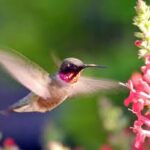
The HUMMINGBIRD –
There is a lovely poem, A Prayer in Spring by Robert Frost… a poem in tribute to Spring with its flowers, orchards, bees and birds…
A Prayer in Spring by Robert Frost
Oh, give us pleasure in the flowers to-day;
And give us not to think so far away
As the uncertain harvest; keep us here
All simply in the springing of the year.
Oh, give us pleasure in the orchard white,
Like nothing else by day, like ghosts by night;
And make us happy in the happy bees,
The swarm dilating round the perfect trees.
And make us happy in the darting bird
That suddenly above the bees is heard,
The meteor that thrusts in with needle bill,
And off a blossom in mid air stand still.
For this is love and nothing else is love,
The which it is reserved for God above
To sanctify to what far ends He will,
But which it only needs that we fulfill.
The poem never mentions the Hummingbird by name, but we recognize it and know by Frost’s words – darting bird, meteor, needle bill, in mid air stand still – in the poem’s 3rd stanza.
What we discover in A Prayer in Spring is the preciousness, the sacredness of moments. Time itself stands as still and also moves as swiftly as the Hummingbird… with God alone knowing what comes next.
But what is the real tweet-tweet on the Hummingbird in real-life? Here are a few little tidbits to pass along to your kids and grandkids to combine literature and life:
– Hummingbirds are found in North and South America, from Alaska to Chile.
– The Hummingbird is known for its rapid beating of its wings, up to 60 – 80 beats per second.
– The Hummingbird’s heart rate can reach up to 1,260 beats per minute.
– The Hummingbird is named for the sound it makes with its rapidly beating wings.
– The Hummingbird has no sense of smell.
– During courtship, the Hummingbird can reach speeds of 60 miles per hour.
– Of all animals in the world with a backbone, the Hummingbird is the smallest.
– The Hummingbird does not flap its wings, but rotates its wings in a figure 8 motion that allows it to fly forward, backwards, up, down and sideways.
– The Hummingbird is able to hover because of its flying muscles that take up 30% of its body.
– The Hummingbird has been known to fly up to 500 miles without stopping during its migration.
– The Hummingbird eats up to 8 times per day, for a total of about 45 seconds at each feeding.
– Hummingbirds migrate to the cooler climates of the United States and Canada each spring to nest.
– The female Hummingbird creates a nest of spider webs, moss and camouflage such as twigs… choosing a location that is safe from strong winds.
– The more colorful male Hummingbird does not hang around after the female is impregnated so as not to attract predators such as orioles, roadrunners and even the praying mantis.
Ah. The Hummingbird in real-life.
Reading the poem A Prayer in Spring with your kids and grandkids, with a little knowledge of the Hummingbird in real-life, gives you so much to discuss… and your kids so much to think about as they embrace the literature.
The poem also gives us a great opportunity to talk with our kids about seasons, renewal, love of nature and the appreciation of moments in time and loving them for their own sacredness, rather than always anticipating what’s to come.
Join me here each day in August for AUGUST TWEET-TWEETS on 365 Days of Literacy for Kids! A little fun, a little learning and a bit of “tweet-tweet”!



